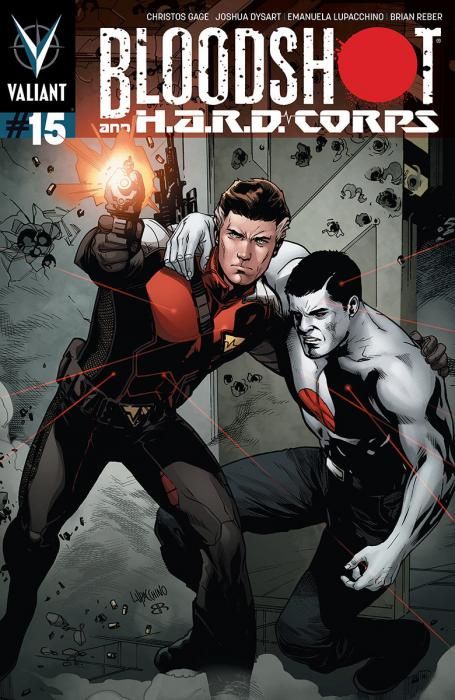"Bloodshot and H.A.R.D. Corps" #15 by Christos Gage, Joshua Dysart and Emanuela Lupacchino is engineered to accomplish two storytelling goals: first, to get Bloodshot back in action after his seeming elimination by Harada in the Harbinger Wars, and secondly, to have Bloodshot formally introduced to H.A.R.D. Corps and combine their forces into one team.
To achieve these ends, the action is fast-paced but heavy-handed. The central conflict of Bloodshot and H.A.R.D. Corps" #15 feels manufactured. H.A.R.D. Corps rescues Bloodshot from Harada, but inevitably, Palmer must square off against Bloodshot before winning him over, and most of the team members get an opportunity to show their chops in battle.
Despite the mechanical feeling of the overarching structure, in the middle of the issue, Dysart and Gage write some enjoyable and unexpected twists. Panic's appearance is unexpected and provokes the only humor in the script when the H.A.R.D. Corps men goofily freak out. Disciple's strength from his faith is also a strong note. Maniac's actions are unsurprising, given his codename, but Harada's response is shocking, even with all the violence that the character has been single-handledly responsible for before this.
The most fleshed-out members of "Bloodshot" previously were his old supporting cast, foils to his strength and muscle, like The Kid or Melissa. Their counter-balancing influences, which highlighted Bloodshot's humanity, have been replaced with soldiers who have killed children. The entire tone of the title has shifted even more heavily into a testosterone-heavy military feel. There are women present, but they exert little to no influence as characters so far.
The new H.A.R.D. Corps debuted during The Harbinger Wars crossover, and their characterization remains shallow. Besides Maniac's hyperactivity, the dialogue doesn't have distinctive speech patterns and what they say does little to distinguish them beyond playing to types. Palmer is the war-weary veteran father figure and leader, Maniac is the loose cannon, Superstar seems to be a good-natured jock, Granite is a stoic, devoted mother and Disciple is a devout believer.
True to the usual style and themes of "Bloodshot," and H.A.R.D. Corps, the action is heavy on gore and weaponry. Matching Emanuela Lupacchino as an artist for "Bloodshot and H.A.R.D. Corps" is an odd editorial choice. She handles the near-nonstop action well, but in matters of style, her work feels too bright and cheerful for a title that has only gotten grimmer. Lupacchino's work is cartoony rather than gritty or gory, and her figures are a little stiff. However, her panel transitions and sense of movement are strong, and her clean linework is attractive and reduces confusion for changes in setting. The script also doesn't make use of Lupacchino's gifts for spacious backgrounds. "Bloodshot" has never provided artists or colorists with much inspiration in setting, and "Bloodshot and H.A.R.D. Corps" #15 is no exception, with its backdrop of metal-walled, boring military compounds.
The weakest part of "Bloodshot and H.A.R.D. Corps" #15 is the end, in which Bloodshot and Palmer have a platitude-heavy conversation which is meant to prop up the issue-ending shot of Bloodshot upright and heroic-looking, ready to re-enter the fray.
With the convergence complete and Bloodshot semi-functional, future issues of "Bloodshot and H.A.R.D. Corps" #15 need to do more with character development to win readers over to the new lineup.

